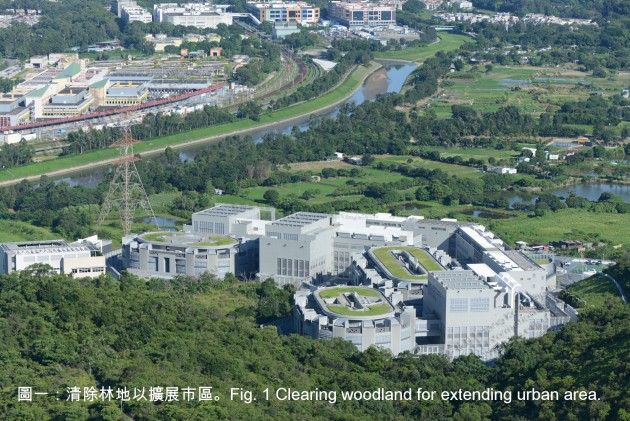生境破壞 Habitat Destruction
29-07-2015
香港提供了各種不同的生境,讓大量的物種得以棲息。然而,當棲息地遭受破壞,以致不能支持物種在該地居住,便會導致物種流失,甚至令一些特有物種滅絕,造成生物多樣性下降。
生境破壞可以由自然因素與人為因素導致,自然因素包括山火、火山活動、氣候變化等,人為因素則有城市發展、農地開墾、基建發展等。在香港,城市與郊區不過一線之隔,因此人類活動與生境破壞更是息息相關。
1. 城市化
香港近年大興土木,無論是新市鎮發展或是丁屋發展,令一片片鄉郊土地和自然生境越趨城市化。郊區轉為城市的結果,便是一些生境如樹林、濕地被移除,變成平地、樓宇。這令原本棲息在該處的生物流離失所。
除了住屋,一些生境也會開發作工商業或娛樂用途,例如開發作貨櫃場(圖二)、度假村或高爾夫球場(圖三)。
城區往鄉郊擴張不僅直接破壞生境,也會間接加劇水土流失,造成土地退化。由於生境植被遭移除(圖四、五),天然排水道被更改,未能去除土壤多餘水分,加上地表鋪上了水泥令雨水難以排走,令地表更容易遭流水侵蝕。失去植物的保護,泥土亦更易受風化影響。結果開發地區以及鄰近地區土地容易變得貧瘠,進一步加速生境惡化。
此外,工程亦會造成各種污染如水污染、空氣污染、土壤污染等,建築物完工後也會帶來人類活動的噪音污染,使一些喜好寧靜的生物如鳥類不得不另覓住處。
2. 興建基建
香港政府於2007年宣佈實行《十大建設計劃》,內容包括港鐵沙田至中環線、港珠澳大橋、新界東北新發展區。然而,興建這些設施的同時,也會對生境造成破壞。
港珠澳大橋是計劃的其中一個項目。大橋位於東涌沿海,由於一段為海上高架橋,需要挖掘海床以建造橋墩(圖六),令海底生物失去容身之所。此外,工程進行時亦會翻起泥沙,興建人工島時也曾懷疑發生運沙船漏沙的情況(圖七),進一步破壞附近海洋生境。大橋建成後,伴隨增加的往來船隻也會騷擾附近水域,甚至對海洋生物的生命構成威脅。
除了《十大建設計劃》,其他基本設施如道路也會隨著城市發展深入郊區,有機會造成生境細碎化,分割環境資源(圖八),使物種的生存更為嚴峻。
3. 非法傾倒垃圾
2005年,建築廢物處置收廢計劃實施,為了逃避收費,一些工程完結後工人會把建築廢料棄置郊外(圖九、十)。部分廢料會釋出毒素,滲入泥土、地下水,或直接進入魚塘、湖泊,污染水生生境。
人類活動會不知不覺地破壞生境,不僅使我們失去美麗的自然景觀,也令物種流失滅絕,當中一些甚至對我們的生活甚有益處,因此在發展城市的同時,我們也應思考如何在發展及保育之間取得平衡,保護香港珍貴的物種和自然生境。
Hong Kong possesses various types of habitats for many different species to live in. However, when these habitats are degraded or destroyed, they can no longer support the organisms living there. This will result in the loss of species, or even extinction of endemic species. In other words, there will be a decrease in biodiversity.
Habitat destruction can be caused by natural or anthropogenic (human-related) factors. Natural causes include hill fires, volcanic activities and climate change, while human causes include urban development, clearing land for agriculture, construction of infrastructure, etc. As urban and rural areas exist shoulder to shoulder in Hong Kong, human activities plays an even more important role in habitat destruction.
1. Urban expansion
Hong Kong has seen rapid urban expansion in recent years resulted from new town and New Territories Small House development. When natural areas are transformed into urban areas, habitats like woodland and wetlands will be replaced by flat ground with buildings (Fig. 1). This takes away the natural shelters of many organisms such as birds and fish.
Other than residential use, some habitats will also be exploited for business or entertainment uses, such as to establish open cargo storage (Fig. 2) resorts and golf courses (Fig. 3).
Not only does urban expansion directly destroy habitats, it also speeds up erosion, which leads to soil degradation. Since vegetation in the area is removed (Fig. 4, 5) and the natural drainage is altered, excess water in the soil cannot be cleared away. Moreover, a layer of concrete covering the topsoil makes is difficult for rainwater to be drained away. These add up to result in easier erosion of soil by water. Besides that, without the protection of plants, the soil is more vulnerable to erosion by wind as well. Eventually, the soil in both the developed area and neighbouring areas would become poor, and habitat deterioration is made more severe.
Other than the above-mentioned, construction work also causes various pollutions such as water, air and soil pollution. Upon completing construction, the subsequent anthropogenic activities will bring noise pollution too. This may force organisms that require a quiet living environment, such as birds, to move and seek shelter elsewhere.
2. Building infrastructures
The Hong Kong government launched the Ten Major Infrastructure Projects in 2007. The Projects include the MTR Shatin to Central Link, the Hong Kong-Zhuhai-Macau Bridge, the North East New Territories New Development Areas, etc. However, when carrying out these projects, habitat destruction is also brought about.
One of the Projects is the Hong Kong-Zhuhai-Macau Bridge, situated along the coast outside Tung Chung. As part of the Bridge involves a sea viaduct, piers have to be built by digging into the seabed (Fig. 6), which causes the loss of shelter of seabed organisms. Also, sand and mud will be stirred up during the construction. There are also incidents, in which a sand barge was suspected to have leaked sand into the water, bringing further harm to the marine environment (Fig. 7). After construction, the increased freight and ferry traffic may further disturb nearby waters or even threatens the life of marine organisms there.
Other than the Ten Major Infrastructure Projects, other transportation structures such as roads will also find their way into rural areas following urban development. This may result in habitat fragmentation, in which natural resources are divided into smaller portions (Fig. 8), making it more difficult for organisms to survive.
3. Illegal waste material disposal
In 2005, the Construction Waste Disposal Charging Scheme became effective. To avoid paying for the waste, some workers would dump waste materials in the countryside after the construction (Fig. 9 and 10). Some of the waste may release toxins, which seep into the land and underground water, or directly enter ponds and lakes, polluting the aquatic habitats.
Human activities may unknowingly damage natural habitats, leading to the loss of beautiful natural scenery. More importantly, it also causes the loss of species, some of which are beneficial to us. Therefore, when carrying out city development, we should also consider how to achieve a balance between development and conservation, and how to protect the Hong Kong’s precious species and natural habitats.




















